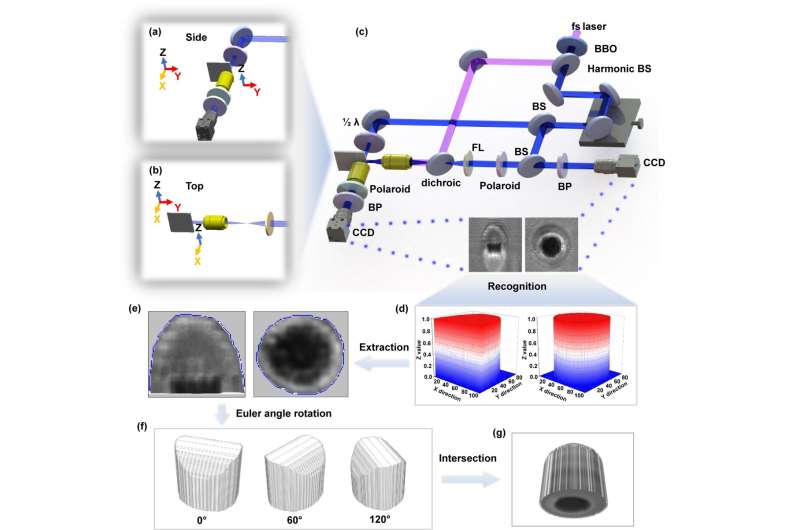This article has been reviewed according to Science X's editorial process and policies. Editors have highlighted the following attributes while ensuring the content's credibility:
fact-checked
proofread
Realizing ultrafast imaging from 2D to quasi 3D

Scientists at Beijing Institute of Technology have developed an ultra-fast quasi-three-dimensional technology, overcoming the shortcomings of missing information in two-dimensional images and incomplete features, allowing for the analysis of three-dimensional characteristics of ultra-fast processes.
The research, published in International Journal of Extreme Manufacturing, demonstrates how to achieve three-dimensional characteristic analysis based on two-dimensional information collection.
Through vertical polarization imaging, high signal-to-noise ratio reflectance-transmittance images were obtained. By contrasting between two viewpoints, phase transition mechanisms were successfully differentiated, and the phenomena of plasma diffraction were elucidated.
Moreover, the reconstructed quasi-three-dimensional images used multiplication by Euler angle rotations, enabling optical property analysis on any cross-section of the plasma. This unveiled the asymmetry of early plasma contraction and divergence morphologies in three-dimensional space.
"This quasi-three-dimensional imaging method breaks through the limitations of the original observational dimensions, enhancing our ability to analyze ultra-fast processes comprehensively. In the future, it will play a significant role in revealing the interaction between lasers and matter," said Jiang Lan, a Chair Professor at Beijing Institute of Technology, and the corresponding author on the research.
"Using the quasi-three-dimensional imaging method, we can analyze the shape and property changes of ultra-fast processes in three-dimensional space," said Yiling Lian, a Ph.D. candidate of Jiang at Beijing Institute of Technology, the first author on the paper.
Although exploring laser-induced ultrafast processes is crucial in strong-field physics, fluid dynamics, and advanced manufacturing, ultrafast processes are difficult to understand in depth because the uneven spatial distribution of a laser field triggers a variety of non-equilibrium processes when interacting with materials, that result in different optical properties and a complex morphology of the excited region.
To delve deeper into potential ablation mechanisms, researchers employed femtosecond pump-probe imaging to study transient optical characteristics. However, during signal acquisition, these ablation processes had a significant impact on the optical response of the target material. Consequently, distinguishing the individual effects of these two factors on reflectivity based solely on the acquired reflection images proved challenging.
Yet, in conventional single-view imaging techniques, 3D information is projected onto a two-dimensional plane, effectively analyzing the evolution of two-dimensional processes. However, under strong excitation, the morphology and properties of matter undergo changes in 3D space, accompanied by interfering signals like refraction and scattering.
Jiang asked, "Could we leverage the principle of binocular imaging to introduce another imaging perspective?"
Jiang believes that due to the ultrashort scale, synchronizing both temporal and spatial of the two perspectives becomes paramount for the experiment's success. Guided by Jiang, Lian adopted orthogonally polarized light to simultaneously image from two perspectives, achieving high-quality signal acquisition. They integrated the image features of both viewpoints to reconstruct a three-dimensional matrix. They termed this approach "quasi-three-dimensional imaging."
The findings demonstrate that quasi-3D imaging not only offers a more comprehensive understanding of plasma dynamics than previous imaging methods, but also has wide potential in revealing various complex ultrafast phenomena in related fields including strong-field physics, fluid dynamics, and cutting-edge manufacturing.
More information: Yiling Lian et al, Ultrafast quasi-three-dimensional imaging, International Journal of Extreme Manufacturing (2023). DOI: 10.1088/2631-7990/ace944
Provided by International Journal of Extreme Manufacturing




















